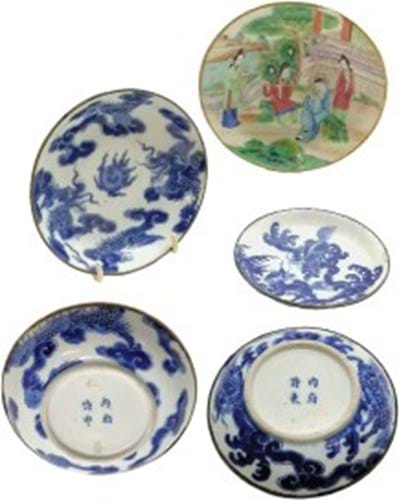
Two Chinese blue and white dishes, examples of the bleu de Huế porcelain, sold with another dish for £20,500 at Acreman St Auctioneers.
Offered together at Acreman St Auctioneers (18% buyer’s premium) in Sherborne with a chipped Cantonese dish of little value, they had been expected to bring just £100-150. The winning bid came online via thesaleroom.com.
Vietnamese buyers have sent the best works of art from the Nguyen (1802-1945) dynasties to unchartered territory in recent years. A particular area of collecting focus is the bleu de Huế porcelain that was made in China to Vietnamese designs. Often these pieces (named after Huế, the Nguyen capital and site of the Forbidden Purple City) include the bespoke marks of royal family members and court officials.
An influential exhibition titled Signed porcelains from the Lê, Trinh and Nguyen Dynasties was held at the Museum of Royal Antiques of Hue in 2018.
The larger of the two pieces offered in Dorset measured 4½in (11cm) across and was decorated to the bowl and the underside with two dragons facing the flaming pearl among waves and clouds. It had both a four-character mark in blue and two incised characters. The slightly damaged smaller dish, decorated with the mythical kylin against a similar ground, had a different four-character mark. Both had the protective silver rims of the type that became popular on Vietnamese porcelain in the late 19th century.
Many of these pieces came to Europe in the years under colonial rule. From the aftermath of the Sino-French War in 1884-85 until the last months of the Second World War, the Nguyen emperors ruled only nominally as heads of state of the French protectorates.
Six-figure success
Extraordinary sums have been achieved for Nguyen bleu de Huế porcelain in both France and Ireland. At Adam’s in Dublin in November 2021, a 6½in (16cm) plate finely decorated with a dragon, a qilin and the khanh (happiness) and tho (longevity) symbols flew to €140,000 (£127,300).
The four-character mark to the reverse read khánh xuân thị tả (Eternal Spring, Left Palace), a reference to a residence owned by the Trinh clan, the family that dominated the royal court in the Later Le period.














